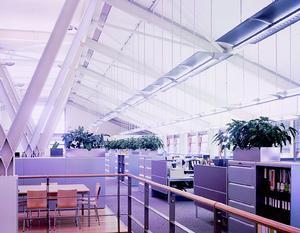Mercifully, the Society of Light and Lighting's (SLL) announcement and forthcoming addendum to LG3 shut the door on the convenience engineering of lighting schemes. Unrelieved arrays of louvres are no longer acceptable practice, and properly-designed supplementary lighting of various kinds is set to become the norm rather than the exception. Innovative controllers will quickly replace bare-lamp louvres over the coming years. This creates a commercial opportunity for consultants who already employ lighting specialists, and should encourage others to follow suit in short order. But wait, is this really what the post-Kyoto world wants? Instead of efficient direct lighting, why is the SLL recommending at least 10% uplight, and other forms of indirect lighting whose utilisation factors are nothing to shout about?
The pages of BSJ over the past several years have been awash with the good intentions of enlightened clients, ardent engineers and eager manufacturers falling over themselves to produce energy-efficient buildings, and the lighting industry has broadly tagged along. The most efficient way to get lumens from the ceiling to the working plane is by using a Cat 2 louvre, but the Society has banned that terminology and outlawed the thinking that goes with it. The withdrawal of categorised lighting is a boon for stressed UK office workers, but could be bad news for Bangladeshi farmers bobbing about in the mouths of the Ganges.
In light of this apparent conflict between the Society's advice and the spirit of Part L and the Enhanced Capital Allowance (ECA) scheme, it's important to remember that from an environmental point of view it's energy consumption that matters, not energy efficiency. The amount of carbon released into the atmosphere is determined by Joules, not Watts, and certainly not W/m2/100 lux. The best measure of environmental impact would be Joules per year per occupant.
From this point of view, both Part L and the ECA scheme are somewhat perverse. According to the Approved Document of Part L, it's fine to vastly over specify lux levels in an office, as long as the light comes from efficient luminaires. In defence of Part L, it is only guidance not a rigid set of rules, and it does at least use light output ratio as the measure of efficiency, which mitigates in favour of indirect luminaires, thus corroborating the Society's recommendations on lighting quality. The ECA scheme on the other hand considers only utilisation factor, a method which promotes neither energy conservation nor lighting quality. It also bizarrely favours compact lamps over linear lamps, despite their poorer efficacy, shorter life and higher mercury content. A further problem with both schemes is that they inevitably create distortions, since engineers must expend their energies trying to comply with documents, rather than thinking each problem through on its own merits.
So is it practical to try to define efficiency? The PROBE studies have suggested that comfort is the absence of discomfort, and if this is true, then efficiency must be the absence of inefficiency. Inefficiency in offices is caused by occupant discomfort, dissatisfaction and distraction. The issues of energy efficiency, comfort and productivity are inextricably linked – efficiency can only meaningfully be defined in conjunction with lighting quality.
Unfortunately it's almost impossible to increase the efficiency of a luminaire without compromising lighting quality. The reason is simple – efficiency involves putting lumens onto the working plane, where lighting quality involves spreading them onto other surfaces, such as ceiling, walls and people. The best approach is to concentrate instead on lamps and ballasts, since increased efficiency does not compromise light quality; and on control systems, which, properly used, can have a highly beneficial effect on light quality by creating dynamic and responsive environments
The specifier or designer's job would be simple if it were possible numerically to weigh up the comfort and productivity benefits of good lighting versus the added environmental cost, but unfortunately this will never be possible. Energy consumption can be accurately measured and sometimes accurately predicted, but attempts to numerically quantify lighting quality have met with failure.
This lack of a numerical crutch needn't be a problem, except that in today's property industry, anything without a number or mnemonic next to it is valueless – putting the onus on the specifier to defend what they know to be best practice.
Most lighters believe that a broad multidisciplinary knowledge is indispensable – being able to juggle the considerations of aesthetics, energy, amenity, ergonomics, electrics and electronics while cutting through charlatanism requires engineers and designers who are numerate, and both visually and literally literate. A multidisciplinary approach is also highly convincing to clients. The future for reconciling energy conservation with visual comfort lies in innovative luminaires, and the judicious use of lighting control systems. Their potential for saving energy and money is demonstrable, and the benefits of visually interesting, subtly varying and controllable lighting conditions are persuasive.
Source
Building Sustainable Design
Postscript
Owen Howlett MA MSc is lighting researcher with Zumbtobel Staff.




















